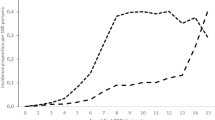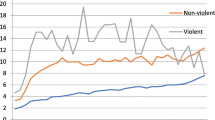Abstract
Secular trends in the criminal activity of conduct disordered adolescents admitted as psychiatric in-patients in Norway were examined. A nationwide sample of 650 adolescents hospitalised with DSM-IV Conduct Disorder during the years 1963–1990 was followed up 12–33 years after index hospitalisation by register linkage to the National Crime Register. In all, 469 patients, 82% of the males and 57% of the females, had a criminal record at follow-up. The study population was divided into four consecutive cohorts and gender-specific cohort differences in registered criminality were investigated, using survival analysis. There was a marked increase and subsequent levelling off in overall registered criminality from the first to the most recent cohort of conduct disordered females, in contrast to unchanged crime rates in conduct disordered males. Monitoring specific types of crime, males’ violent crime rates initially increased but levelled off in more recent cohorts, whereas female violent crime rates increased steadily, with the highest level seen in the most recent cohort. A marked increase in drug offences was observed in both genders. Cox regression demonstrated numerous strong cohort effects, even when controlling for other important factors, including substance use comorbidity. Research into causal mechanisms is warranted.
Similar content being viewed by others
References
American Academy of Child and Adolescent Psychiatry (1997) Practice parameters for the assessment and treatment of children and adolescents with conduct disorder. J Am Acad Child Adolesc Psychiatry 36:122S–139S
American Psychiatric Association (1994) Diagnostic and statistical manual of mental disorders, 4th edn. American Psychiatric Association, Washington, DC
Blumstein A, Cohen J, Farrington DP (1988) Criminal career research: its value for criminology. Criminology 26:1–35
Brestan EV, Eyberg SM (1998) Effective psychosocial treatments of conduct-disordered children and adolescents: 29 years, 82 studies, and 5,272 kids. J Clin Child Psychol 27:180–189
Dishion TJ, McCord J, Poulin F (1999) When interventions harm. Peer groups and problem behavior. American Psychologist 54:755–764
Doob AN, Sprott JB (1998) Is the “quality” of youth violence becoming more serious? Can J Criminol 40:185–194
Farrington DP (1994) The twelfth Jack Tizzard memorial lecture. The development of offending and antisocial behaviour from childhood: key findings from the Cambridge study in delinquent development. J Child Psychol Psychiatry 36:929–964
Fombonne E (1998) Increased rates of psychosocial disorders in youth. Eur Arch Psychiatry Clin Neurosci 248:14–21
Henry DB, Tolan PH, Gorman-Smith D (2001) Longitudinal family and peer group effects on violence and nonviolent delinquency. J Clin Child Psychol 30:172–186
Kjelsberg E (2002) DSM-IV Conduct Disorder symptoms in adolescence as markers of registered criminality. Eur Child Adolesc Psychiatry 11:2–9
Kjelsberg E, Dahl AA (1998) High delinquency, disability, and mortality—a register study of former adolescent psychiatric inpatients. Acta Psychiatr Scand 98:34–40
Loeber R, Stouthamer-Loeber M, White HR (1999) Developmental aspects of delinquency and internalizing problems and their association with persistent juvenile substance use between ages 7 and 18. J Clin Child Psychol 28:322–332
Moffitt TE (1993) Adolescence-limited and life-course-persistent antisocial behavior: a developmental taxonomy. Psychol Rev 100:674–701
Moffitt TE, Caspi A, Rutter M, Silva PA (2001) Sex differences in antisocial behaviour. Cambridge University Press, Cambridge
Myers MG, Stewart DG, Brown SA (1998) Progression from conduct disorder to antisocial personality disorder following treatment for adolescent substance abuse. Am J Psychiatry 155:479–485
Offord DR, Bennett KJ (1994) Conduct disorder: long-term outcomes and intervention effectiveness. J Am Acad Child Adolesc Psychiatry 33:1069–1078
Prosser J, McArdle P (1996) The changing mental health of children and adolescents: evidence for a deterioration? Psychol Med 26:715–725
Robins LN (1996) Deviant children grown up. Eur Child Adolesc Psychiatry 5:44–46
Robins LN, Tipp J, Pryzbeck T (1991) Antisocial personality. In: Robins LN, Regier DA (eds) Psychiatric disorders in America: the Epidemiologic Catchment Area study. The Free Press, New York, pp 258–290
Rutter M, Smith DJ (1995) Psychosocial disorders in young people. Time trends and their causes. John Wiley and Sons, Chichester
Smith DJ (1995) Youth crime and conduct disorders: trends, patterns, and causal explanations. In: Rutter M, Smith DJ (eds). Psychosocial disorders in young people. Time trends and their causes. John Wiley and Sons, Chichester, pp 389–489
Snowdon J, Hunt GE (2002) Age, period and cohort effects on suicide rates in Australia, 1919–1999. Acta Psychiatr Scand 105:265–270
SPSS for Windows, Release 11.0 (2001) SPSS Inc
Stattin H, Magnusson D (1991) Stability and change in criminal behaviour up to age 30. Br J Criminol 31:327–346
Van Kammen WB, Loeber R, Stouthamer-Loeber M (1991) Substance use and its relationship to conduct problems and delinquency in young boys. J Youth Adolesc 20:399–413
White HR, Bates ME, Buyske S (2001) Adolescence-limited versus persistent delinquency: extending Moffitt’s hypothesis into adulthood. J Abnorm Psychol 110:600–609
Author information
Authors and Affiliations
Corresponding author
Rights and permissions
About this article
Cite this article
Kjelsberg, E. Conduct disordered adolescents hospitalised 1963–1990. Europ.Child & Adolescent Psych 14, 191–199 (2005). https://doi.org/10.1007/s00787-005-0444-0
Accepted:
Issue Date:
DOI: https://doi.org/10.1007/s00787-005-0444-0




